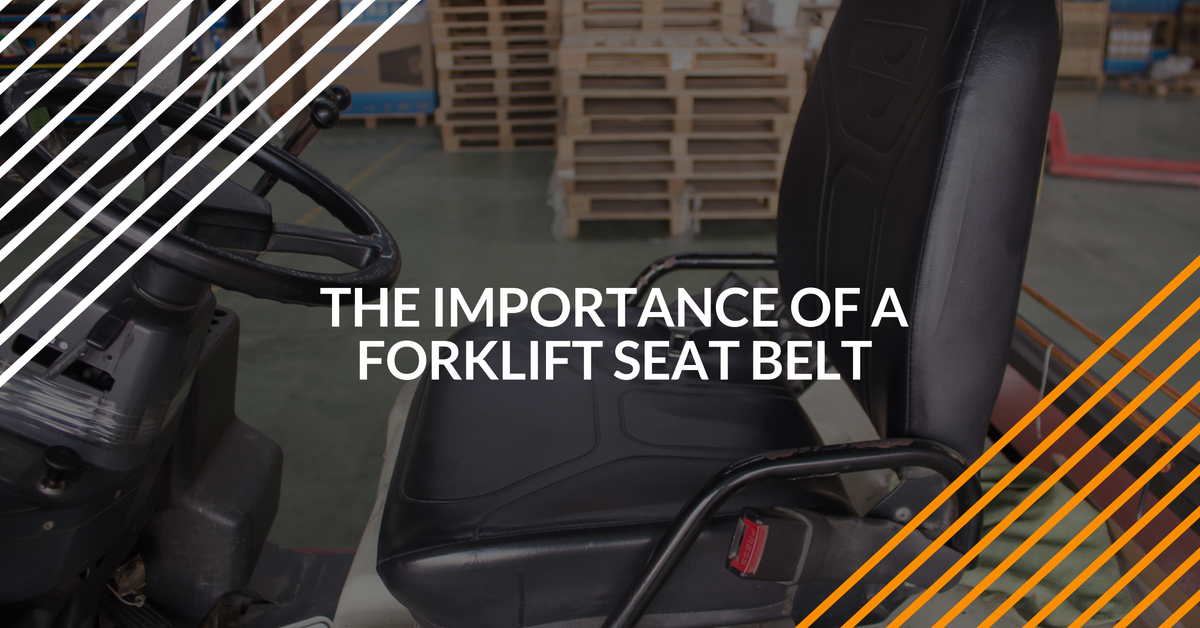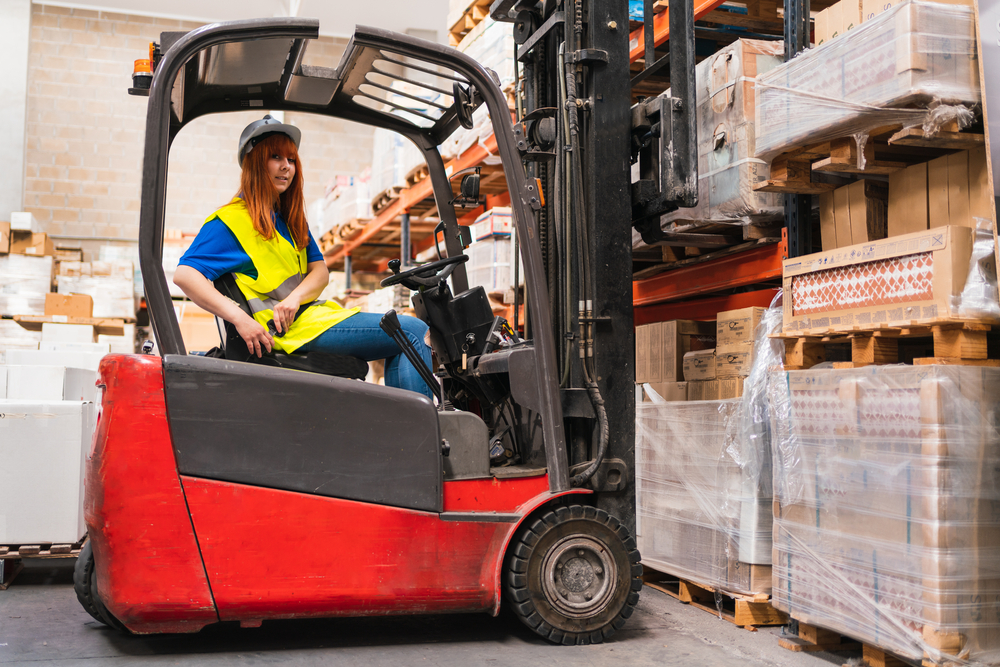All About Forklift Seat Belt Safety

Our OSHA forklift training reviews important safety measures you need to know to operate a forklift — including seat belt use. Forklift seat belts are required by OSHA regulations. Think about it — you’d never drive a car with known hazards ahead on the open road. It’s not only dangerous — but it’s also against the law!
Ensure you’re up to date with OSHA seat belt requirements. FLC’s training includes comprehensive forklift seat belt safety guidelines, along with other content to get your entire forklift fleet certified. Upgrade your safety program today with FLC and make sure you’re always in the loop with the latest OSHA guidelines.
This article will review the importance of forklift seat belts, why OSHA requires their use, some common accident outcomes improved with seat belts, and other helpful information. Keep reading to learn more about this important forklift safety topic!
WHY IS A FORKLIFT SEAT BELT IMPORTANT?
The safest place for an operator is strapped into the seat of the forklift with the seat belt fastened. The purpose of the forklift seat belt is to rob the operator of their most instinctual reaction; to jump away from the tipping forklift. Workers panic when they’re inside a tipping forklift and believe they are better off trying to get away from it. But it is difficult to jump away far enough and manage to jump straight through the opening of the doorway around the cage and seat.
Another reason why there are OSHA regulations on forklift seat belts is how often they’re actually used to save lives and prevent injuries. For the most recent OSHA 10 Most Frequently Cited Standards, powered industrial trucks (including forklifts, pallet jacks, man lifts, narrow aisle lifts & more) were once again included in the list. Tip-overs, collisions, and other accidents contribute to the frequency of forklift incidents. Proper forklift seat belt safety measures go a long way in preventing the most serious injuries – and even fatalities – related to accidents involving powered industrial trucks.
In addition to causing more serious injuries and fatalities, the lack of enforcement of OSHA forklift seat belt safety can lead to thousands of dollars in OSHA fines.
ARE SEAT BELTS REQUIRED ON FORKLIFTS?
The first rule in operating a forklift: even before starting to move, you must wear a forklift seat belt. Forklift operators are required to wear a seat belt — without exception. Failure to wear a seat belt while using a forklift puts the operator, their coworkers, and bystanders in danger. It could also lead to OSHA fines and penalties.
OSHA stressed the importance of forklift seat belts with a special memo, Enforcement of the Use of Seat Belts on Powered Industrial Trucks in General Industry, published in 1996. There was some confusion about some forklifts not requiring seat belts. As a result, OSHA issued their highly detailed message for all U.S. employers. Since the mid-1990s, there has been no doubt about OSHA seat belt requirements; they’re always required when a forklift is in use.
OSHA SEAT BELT REQUIREMENTS: WHAT YOU NEED TO KNOW


- Dockyards
- Warehouses
- Distribution centers
- Marinas
- Construction sites
- Landscaping jobs
- Anywhere else a forklift is used
Understanding OSHA forklift seat belt requirements is paramount for forklift operators and their employers. To illustrate this point, let’s consider a real world example.
An experienced forklift operator was once fired after he failed to wear a seat belt. The operator disputed the termination, and he argued that he had to exit his forklift approximately 20 times in a three-hour span. Regardless, the operator still lost his job, due to the fact that he did not follow the proper forklift seat belt safety protocols.
The aforementioned example shows that employees are responsible for wearing a seat belt when they use a forklift — or they could risk losing their job. But, it is also important to note that an employer may face fines if an accident or injury occurs that is related to a forklift operator’s failure to wear a seat belt.
For example, a company was prosecuted and fined $60,000 after it was discovered that one of its workers did not wear a seat belt when operating a forklift. The worker’s foot was crushed in a forklift accident; meanwhile, the worker was not licensed to operate a forklift, and no systems or training programs were in place to teach employees about forklift safety.
Forklift operators and their employers share responsibility for complying with OSHA regulations for forklift seat belts. Together, both parties can follow OSHA guidelines relating to the use of seat belts on forklift and other forklift safety topics. They can also ensure that forklift operators and others are protected against workplace accidents, injuries, and fatalities.
The bottom line: always follow OSHA forklift safety requirements, and require workers to wear a forklift seat belt. In doing so, you can keep your forklift operators safe and avoid OSHA fines and penalties.
WHAT ARE FORKLIFT TIP-OVERS?
Forklift tip-overs are the most deadly type of forklift accident according to the CDC. Forklift tip-overs are caused by workers driving too fast, turning around corners too fast, carrying too heavy loads, accessing a ramp wrong, and carrying an unbalanced load. These are just some of the most common causes of forklift tip-overs, but there are many others. Make sure to check out our helpful article on how to prevent tip-overs.
The importance of seat belts is evident in OSHA’s forklift accident statistics. According to OSHA, there are about 80 to 100 forklift fatalities every year in the United States. Many of these are caused by tip-overs. So the next time your employees ask are seat belts required on forklifts, the answer is, absolutely, yes!
In addition to tip over accidents, serious injuries and fatalities caused by being crushed under a fallen forklift are another top accident. OSHA has created a regulation requiring that all industrial machines manufactured after 1992 be equipped with seat belts and other restraints.
While OSHA does not have a law that specifically requires seat belt use, they do require that employers provide a safe working environment for workers free of recognized hazards, and enforcing seat belt use to prevent tip-over accidents is included in this regulation.
Why would a forklift tip over? Some of the main causes include traveling too fast, unbalanced cargo loads, and transporting heavy weight up or down a slope. Tip-overs can happen. Be prepared by always wearing your forklift seat belt. It’s simply the smart thing to do!
WHY DO FORKLIFT TIP-OVER FATALITIES OCCUR?
The main reason why workers die from forklift tip-overs is that they fall from or attempt to jump from the tipping forklift and aren’t wearing a seat belt. When a worker is caught underneath a forklift, the weight of the machine can liquefy or splinter a limb and render it inoperable at best, or fatally crush the work at worst.
Let’s revisit those 80 to 100 yearly forklift fatalities from OSHA’s records. Approximately half of those deaths occur due to forklift drivers being crushed from tipped over equipment. Knowing how to handle tip-overs and the importance of seat belts are critical in the event of an accident.
During a forklift tip-over, an operator should never jump from the lift. Instead, the operator must follow these steps to reduce the risk of a serious accident or injury:
- Keep both hands on the steering wheel while bracing for the tip-over
- Press both feet into the floor of the lift to brace and minimize movement
- Lean away from the impact
To avoid a tip-over, stay at a safe speed, keep your lift’s max load capacity in mind, avoid obvious terrain hazards, and use caution when navigating slopes, turns, and other dangerous areas. Despite the most careful safety precautions, forklift tip-overs happen. And if you’re secured with a forklift seat belt, there’s less of a chance you’ll be hurt.
STAY CURRENT WITH OSHA’S SEAT BELT REQUIREMENTS
Today’s OSHA regulations aren’t necessarily going to be tomorrow’s OSHA regulations. OSHA seat belt requirements could update at any time. FLC’s OSHA compliant forklift seat belt safety training always includes the most up-to-date information based on current OSHA regulations. That’s why it’s smart to partner with FLC for all of your training and certification requirements. From OSHA seat belt requirements to creating a sustainable forklift maintenance plan to anything else related to safety, we’ll get all your drivers up to speed in no time at all!
Tip-overs are one of the most common accidents involving forklifts and often lead to serious injuries and fatalities. However, they are preventable with safety tools like seat belts and proper forklift certification training from reputable online schools like FLC. If you’d like to learn more about our online courses, please contact us online or give us a call at (888) 278-8896.
